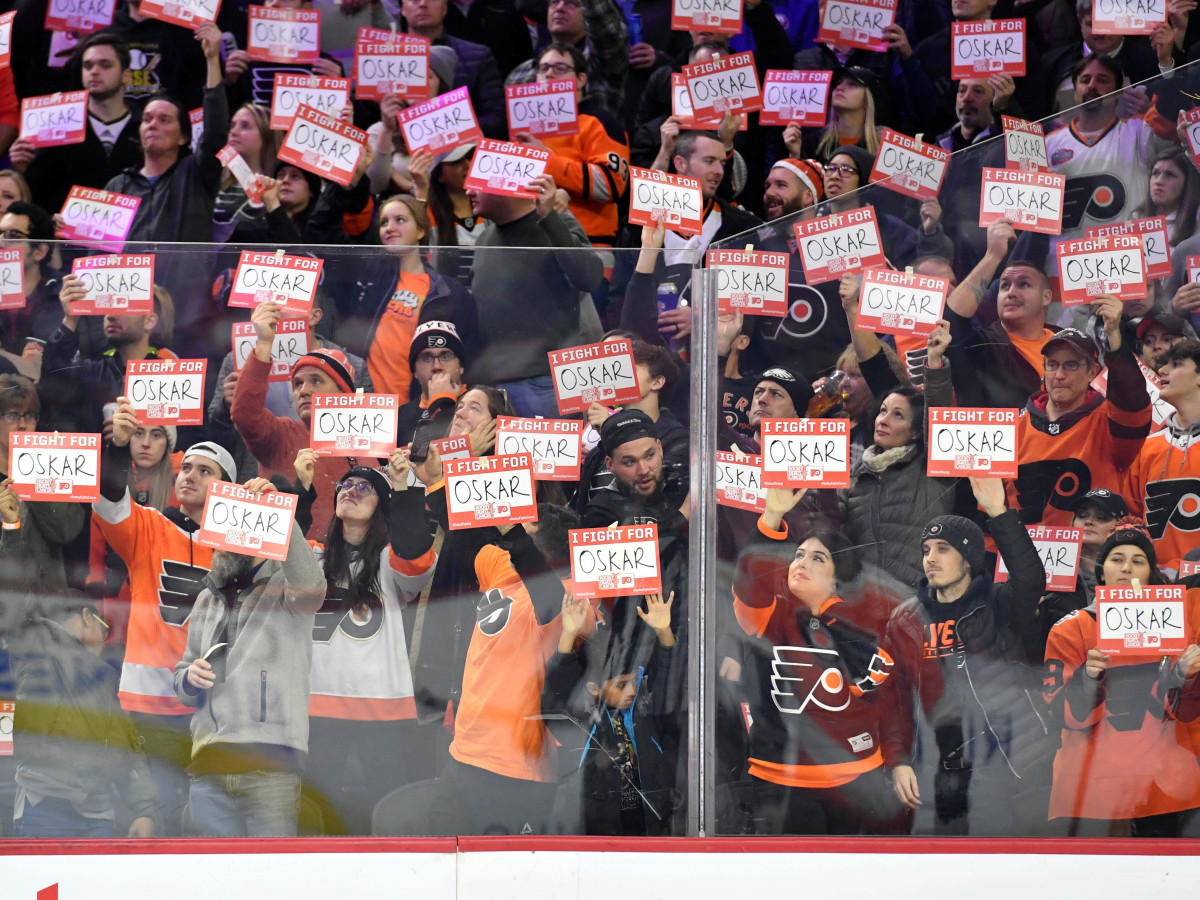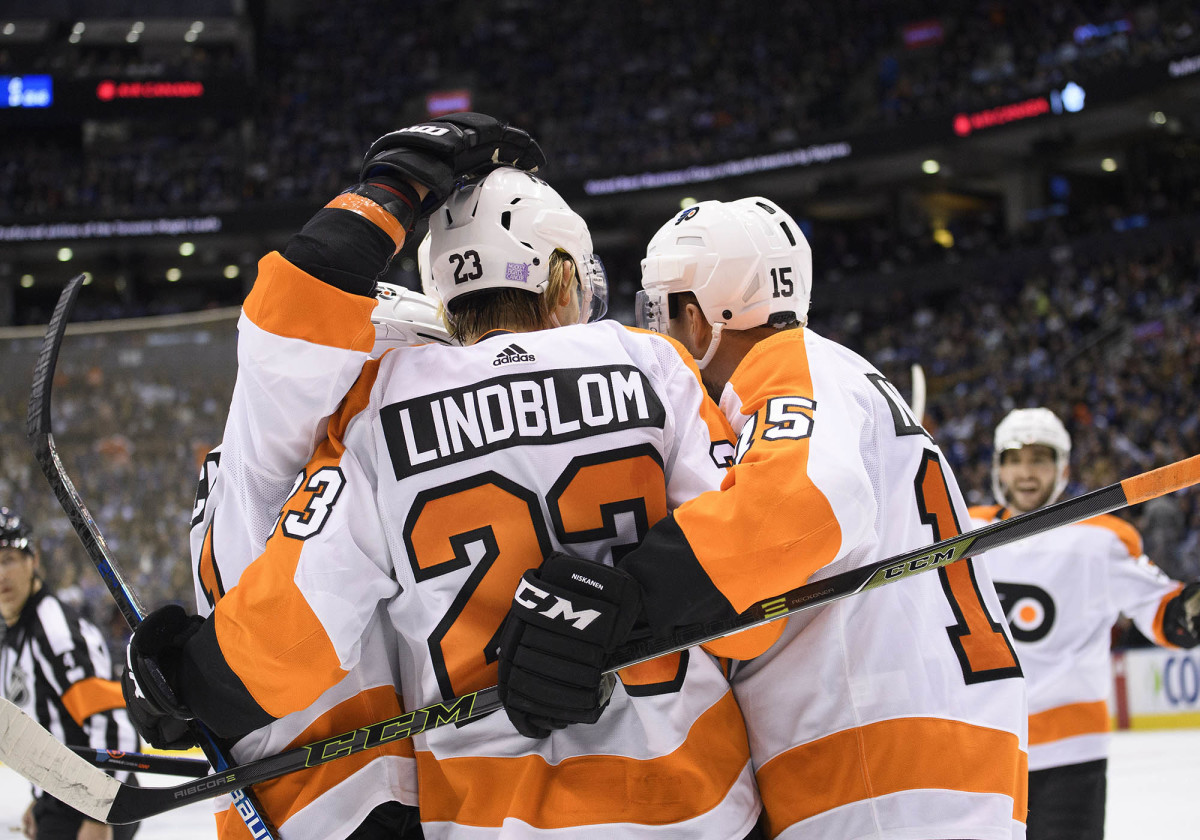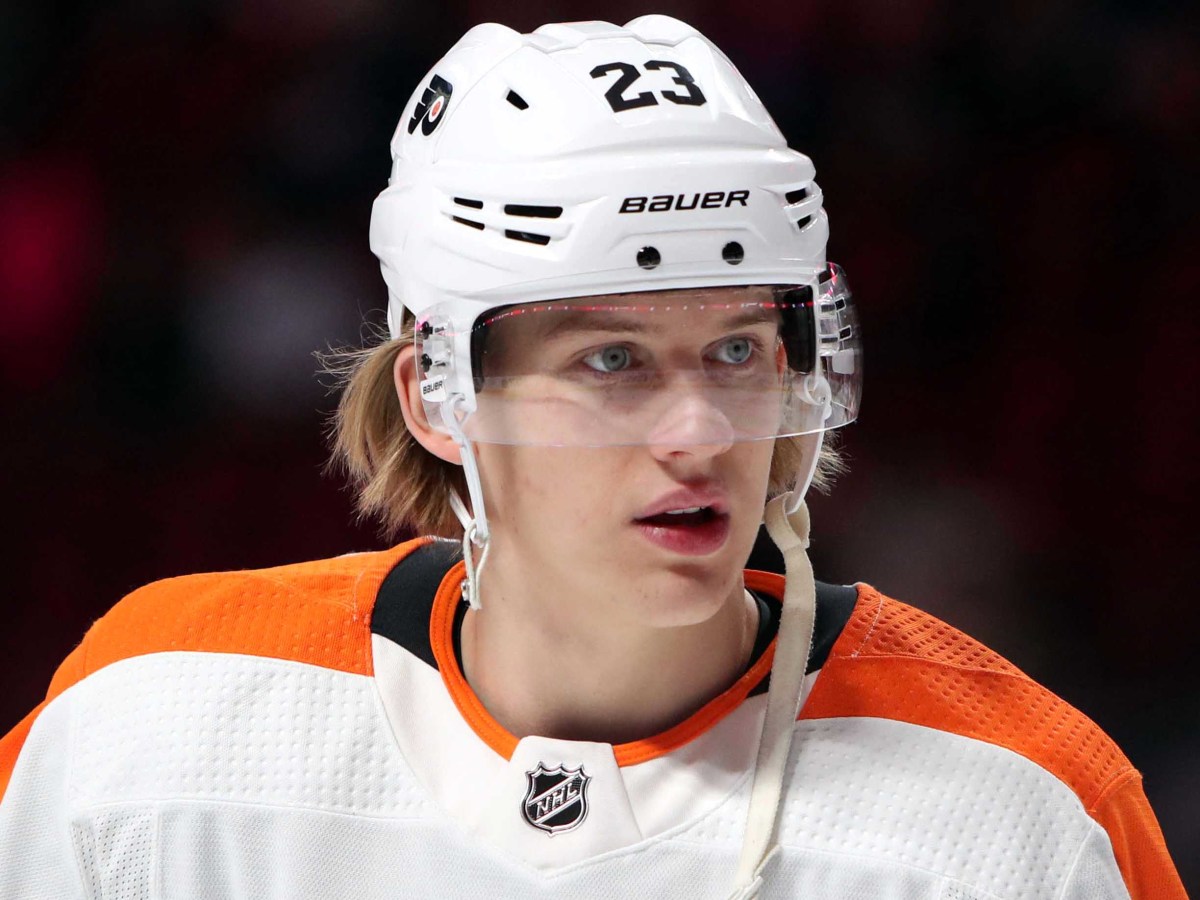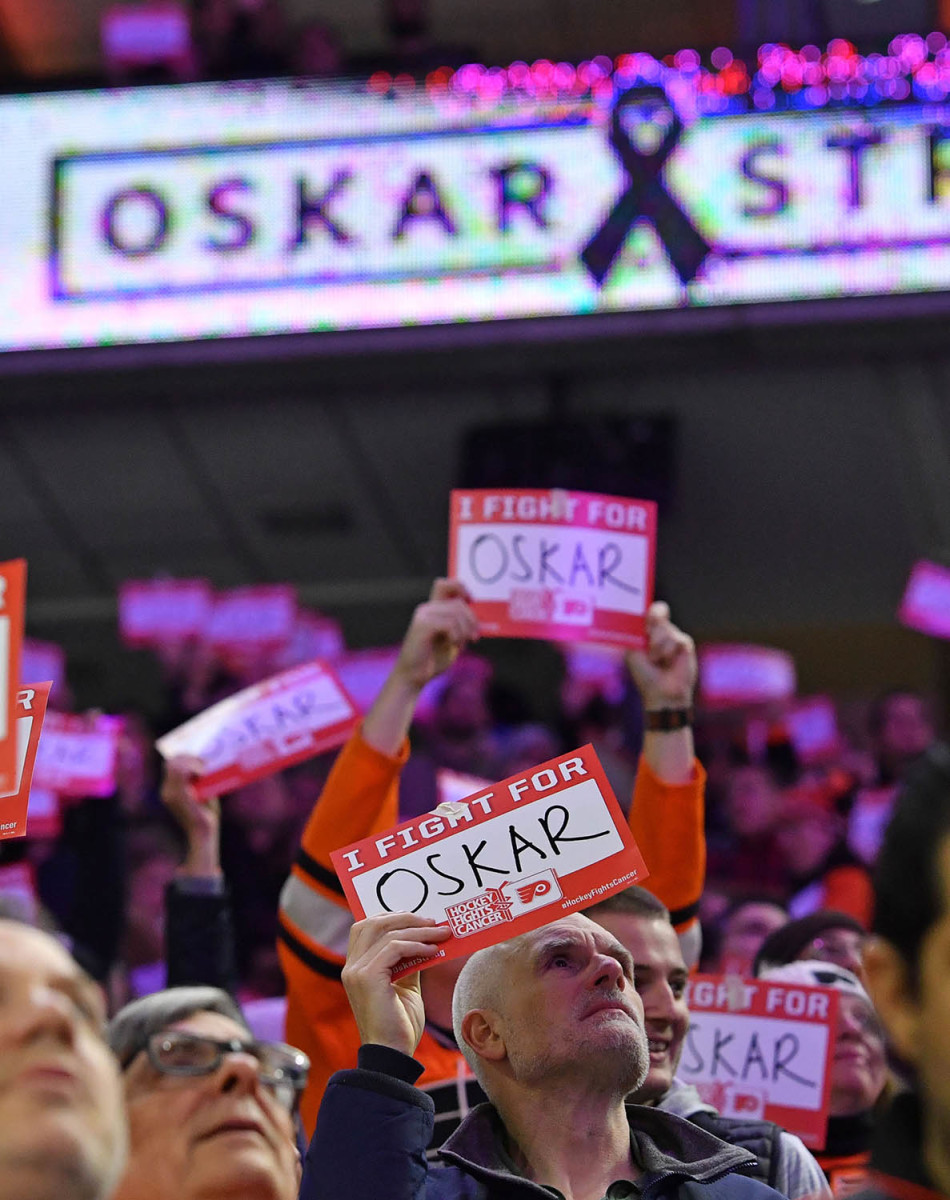Staying Oskar Strong: Flyers' Lindblom Opens Up About Cancer Battle
On July 2, while their most prominent patient was busy receiving his final dose of chemotherapy in a nearby infusion suite, the nursing staff at the Abramson Cancer Center of the University of Pennsylvania staged a covert operation to celebrate the occasion. T-shirts were delivered and donned, each bearing a message of support like OSKAR STRONG, or FIGHT WITH OSKAR. Group texts were sent, counting down the treatment time so everyone could gather early for the big surprise. “He didn’t know any of that was coming,” nurse practitioner Laetitia Simeral says. “It was a very last-minute thing.”
Even with his face hidden behind a medical mask, the stadium-wide grin was unmistakable when Oskar Lindblom soon strode down the hallway from his private patient room—“Last time!” he announced en route—and found a fleet of nurses cheering his arrival at the checkout desk. As it turned out, Lindblom had planned a surprise for them too. After ringing a small bell on the wall to signal the end of his therapy, and wrapping girlfriend Alma Lindqvist in a hug, the 23-year-old Philadelphia Flyers winger produced one of his orange No. 23 jerseys, which he’d autographed and inscribed with a note: THANK YOU FOR EVERYTHING!
“Probably the best feeling of my life,” Lindblom says now. “That’s a great day I’ll always remember.”

It had been more than six months since Lindblom was diagnosed with Ewing’s sarcoma, a rare bone cancer, and began a grueling chemotherapy regimen that would test his resolve in ways that he’d never faced on the ice. Then 30 games into his third NHL season, Lindblom was tied for the Flyers lead with 11 goals and skating 17:37 a night, an encouragingly strong start in a contract year that came to an abruptly jarring halt. “One day, I played hockey,” Lindblom says. “The next, I got cancer.” And yet, through all of the physical pain and mental fatigue that he would endure before he could ring the bell—not to mention a major surgery, a minor setback, and a global pandemic—Oskar never once grouched. “He left with the same smile that he had on when he walked in,” Simeral says.
According to his medical team, Lindblom is officially deemed “without evidence of cancer at this time.” The hedge is preferred to “cancer-free,” Simeral explains, as the disease can manifest microscopically, out of sight of scans. But, for all intents and purposes, Lindblom has body-checked his greatest opponent into oblivion. “Just trying to be positive, the time did go by pretty fast,” says the Gävle, Sweden, native in his first English interview about his cancer battle. “Then when you see people getting inspired from you, sending you a text, sending you a DM on Instagram, you get even more positive because you know you’re helping people out.
“It’s been tough, but you learn a lot about yourself. You can complain that you’re tired one day, you don’t want to go to work, you don’t want to work out… I probably shouldn’t complain when I’m healthy and I have my dream job of playing hockey and can just be thankful for life.”
***
Looking back, Lindblom can readily recall few specifics about the events that led to the discovery of his cancer, so fogged are his memories by the shock that followed. “It was quick when it happened,” he says. “When I think about it, I know my thought process, but I can’t see it in front of me.”
He can, however, see the bump.
At first, Lindblom figured that it was the result of a cross-check to his ribs that he had taken during a recent Flyers game. A little swelling, a little bruising, just the normal wear-and-tear of the job. “It wasn’t big at all, like the size of half of a golf ball,” he says. “I thought it’s nothing, ya know?” Where Lindblom was content to wait for the welt to subside, Lindqvist was more alarmed. “She pushed me: You need to look this up,” Lindblom says. “I didn’t think this could be cancer. Luckily my girlfriend did. I have her to thank for that.”
After scoring his 10th goal of the year in a win over Detroit on Friday, Nov. 29, Lindblom was evaluated by the Flyers’ medical staff, who scheduled a CT scan for the following Monday. When that returned inconclusive, Lindblom received an MRI and a biopsy later in the week. Medically cleared to keep playing while he waited for a conclusion, Lindblom appeared in four more games before his season was cut short. It was a welcome escape from the looming uncertainty. “When I was on the ice, I didn’t think about it,” he says. “But when you’re at home, you don’t have anything to do, it’s hard to let it go.”
The results still hadn’t come back by the afternoon of Dec. 10, when Lindblom and the Flyers flew to Colorado to begin a three-game road trip. It wouldn’t take much longer. Upon checking into his room at the hotel, Lindblom received a call to come down to the lobby. Stepping off the elevator, he was met by the Flyers’ director of medical services, Jim McCrossin, and defenseman Robert Hagg, his closest friend on the team. His face paled. “I understood right away that it wasn’t something good,” he says.

From there the trio decamped to coach Alain Vigneault’s room, where McCrossin proceeded to break the news that he had just received from Lindblom’s doctors at the University of Pennsylvania, and subsequently passed along to Hagg and Vigneault: According to the biopsy, the lump protruding from his ribs was cancerous. “After that, I don’t know that there was a dry eye in the room,” McCrossin says.
With the doctors’ approval, Vigneault offered that Lindblom could remain on the road trip for a few more days if he wanted to be close to his teammates. But Lindblom elected to fly home the next morning, ordering room service and staying up late with Hagg as the friends attempted to process what they’d heard. “That big smile disappeared for a while,” Hagg says. “I could see in his eyes. Everything was empty. He was going to Colorado to play a hockey game and life was normal and everything changed in a couple seconds. We tried to talk about it, but we didn’t know exactly what type of cancer it was, or what the next steps were going to be. I tried to stay positive. That’s the only thing you can do.
“And after a while, he seemed positive too. He just found out half an hour ago that he had cancer, and we were still half-joking with each other. I guess that’s how he is.”
Back in Philly, Lindblom met with Simeral and Dr. Lee Hartner, clinical director of sarcoma medical oncology at Pennsylvania Hospital, who spelled out the finer details of his condition. That Ewing’s sarcoma is most prevalent among children yet only affects 1 in 1 million people in the U.S. per year overall. That it most often originates in long bones in the legs, or in the pelvis, and not in the chest cavity as it did with him. That the survival rate for cases such as Lindblom, whose cancer hasn’t metastasized and whose treatment involves some combination of surgery, chemotherapy and radiation, hovers around 80%.
“We found it early, so it was all good, positive news,” Lindblom says. “They told me that they should be able to take the tumor away, and that hopefully my body responds well to chemo and it should be good to go after these six months.” Even so, his mind raced. “My first thought was, Can I play hockey anymore? I don’t know if I can do anything else. That’s my thing. But then I realized, this is probably not about hockey anymore. I’ll just be happy if I can live like a normal person afterwards.”
With his first chemotherapy appointment scheduled just before the New Year, Lindblom had a few weeks to prepare himself for the fight ahead. He donated sperm to guard against the treatment’s potential side effects on male fertility, as he and Alma plan to have kids. A port device was implanted and sutured into his chest, ultimately to help administer the five-drug cocktail of his standard Ewing’s regimen.
The wait was plenty unwelcome at times, worsened by the fact that he wasn’t able to join his teammates on the ice. But Lindblom drew energy from a few scenes of familiar comforts. One came when the Flyers returned home in mid-December, winless and outscored 14-5 on the Colorado trip, and Lindblom visited the team at its morning skate. It was the first time that all but a few players had seen him since the diagnosis. "I was just happy to be there and watch and talk to them," he says. That night, Philadelphia routed Anaheim to spark a four-game winning streak. "I couldn’t play hockey on that whole trip. I was on another planet, it felt like," Hagg says. "But after a few days, I realized that Oskar wanted us to keep going, to keep fighting."
Another came when Lindblom returned to Gävle for Christmas, the first time in years that he had been able to do so during the hockey season. Crowded around a big table at his grandparents’ house alongside some 30 relatives, he sipped beers and chowed down on a full spread of “classic meatballs, sausages, Swedish smörgåsbord, all kinds of fish…” Plenty of family and friends had questions about his cancer, and Lindblom didn’t mind sharing how he was feeling. But mostly it didn’t cross his mind.
“Just talking to everyone, having fun, I felt good,” he says. “Talking it all in, I was happy. Even though I knew I was going to go through hell with the chemo.”
***
Asked to pinpoint his toughest moment over the past six months, Lindblom cites the physical drain of his first treatment. “It didn’t expect it at all, how bad I would feel afterwards,” he says. “I couldn’t see the end of it. Knowing it’s going to take that long, feeling that bad, that was probably the worst part.”
From there, Lindblom settled into an exhausting routine, reporting to the hospital every two weeks to receive chemo in alternating A and B cycles. The A cycle was relatively easy, just one full-day session followed by a week and a half of rest. By comparison the B cycle was a marathon, consisting of five straight sessions during the week, two to four hours each day. “Then between treatments, he had to take some additional medications, give himself injections, and deal with the side effects,” Simeral says.
Nausea and exhaustion were familiar nemeses, confining Lindblom to his couch at home in the immediate aftermath of each cycle. His hair started falling out in clumps, so he shaved off what was left. But his body recovered fast. Before long, he would invariably muster enough energy to take long walks with Lindqvist and their one-and-a-half-year-old Dachshund, Taggie. Or even to get the blood flowing with some band exercises and body weight workouts. Later on, he would acquire a pair of rollerblades and skate around a nearby parking lot to keep his stride sharp.
“I was looking forward to those days,” he says. “That was my thought process the whole time: I just had to go through some bad days, then I’d have a couple feeling good, then start over again.”

As expected, the hockey community helped in spades too. Philadelphia defenseman Shayne Gostisbehere sent over some dumbbells and other workout equipment, McCrossin says, and the team helped arrange for the delivery of an exercise bike. Hagg and his girlfriend Klara Svedberg, neighbors in Lindblom’s apartment complex near the Ben Franklin Bridge, cooked meals and dog-sat. Other teammates took turns ordering full dinners for delivery. And when Lindblom appeared on the Wells Fargo Center video screen on Jan. 11, ensconced in a luxury suite while watching the game against Tampa Bay, the home crowd responded with a standing ovation. “That was unreal,” he says. “All that love is something I’ll never forget.”
Flyers fans across the country, meanwhile, sent care packages containing everything from blankets to energy stones to simple handwritten notes wishing him well. Sales of OSKAR STRONG tees fetched more than $100,000 for Hockey Fights Cancer in less than a week. NBSCN broadcaster Eddie Olczyk, who conquered colon cancer in 2018, mailed a copy of his new book, Beating the Odds in Hockey and in Life and sent Lindblom some texts. Another well-known survivor, Mario Lemieux, called on the phone. “Real nice to hear from people who have been through something similar,” Lindblom says.
A huge hurdle was cleared on March 3, a little more than a third of the way through his treatment, when Lindblom elected to have surgery to remove the embedded tumor rather than receive radiation therapy. (According to McCrossin, some of Lindblom’s ribs were also reconstructed with Kevlar and “mesh on the outside and the inside of the cage to strengthen it up.”) The operation took its toll. “Of course, he was down for a couple days because he felt like s---,” Hagg says. But tests of the surrounding tissue and muscle revealed the best result possible: no more cancer was visible, and it hadn’t spread.
“I could definitely see that he saw a light in the tunnel,” Hagg says. “He started talking more about how many days he had left.”
Less than a week later, Lindblom surprised the Flyers at their team picture at Wells Fargo Center, sporting his No. 23 jersey and a shaved head. It was only his second time on the ice anywhere since his diagnosis in early December, previously taking a quick, quiet twirl in a tracksuit alongside Lindqvist and Taggie at the practice facility in January when no one else was around. “You could tell, the whole team was genuinely so happy to see him, see his smile,” Hagg says. “He spread energy through the whole team.”
Once the pandemic hit, though, Lindblom was increasingly isolated; not even Lindqvist was allowed to accompany him into the hospital for his treatments. Reading Olcyzk’s book, playing Nintendo Switch and FaceTiming friends in Sweden filled the hours in his sun-splashed private room in the infusion suite. So did conversations with Simeral and the rest of his medical team. “I fondly remember sitting in the exam room and him telling me to watch Tiger King,” Simeral says. But even though the NHL was allowing team facilities to remain open for rehabbing players while on COVID-induced hiatus, and even though Lindblom was orthopedically cleared to resume workouts less than a month his surgery, doctors often advised that his immune system was too weak to take the risk and do what he wanted most.

The few exceptions were cherished. Like when Lindblom called McCrossin in April and asked if he could swing by the rink to skate, having been blessed with the medical all-clear. Entering an empty locker room that day, he sat down at his stall and changed into his full practice uniform—jersey and shoulder pads, shin guards and helmet, every bit of equipment that he hadn’t worn in months. Then he took the ice by himself and fired pucks into an open net while McCrossin watched from afar.
“Your hands are there, your skills are there,” McCrossin recalls quipping after Lindblom was finished.
“Yeah, but I can’t breathe,” Lindblom replied, winded from what would’ve once been a cakewalk workout.
“Come on, kid,” McCrossin said. “You’re battling cancer. Give yourself an A-plus for just being out there.”
***
The night after his final treatment, Lindblom made the short walk with Lindqvist for dinner at Hagg’s apartment. He had left the hospital just as nauseous and tired as usual, but all that evaporated into the relaxing summer air. “It’s funny how the body works,” Lindblom says. “The happiness took over.”
Midnight passed on the balcony where they sat, and conversation continued to flow. “Just talked about the whole thing that he’s been going through for the past eight months,” Hagg says. Recounting this moment over the phone, the 25-year-old grows emotional and takes a second to collect himself. “Both him and Alma thanked us so much for being there the whole time,” he says. “The first day they were cancer free, they wanted to come and say thank you to us. That meant a lot.”
They are far from the only ones whom Lindblom has impacted. Take the children at the Abramson Cancer Center, who received a surprise video message from one of their fellow patients: “Hi, it’s Oskar Lindblom here from the Philadelphia Flyers. I know what you guys are going through firsthand, and I just want to congratulate you on being so strong and so brave. You’re all in my thoughts.”
Take the nursing staff that plans to frame his jersey and hang it on the wall of the infusion center. (Lindblom also gave separate autographed jerseys to McCrossin and Simeral as thanks.) Or the dozens of survivors whose letters stacked so high that Lindblom enlisted Lindqvist’s help to read them all. Or the many others in the future who might, he hopes, remember his story and see a doctor about that unfamiliar bump. “If you go and find out early, it’s going to help you in the long run,” Lindblom says.
Lindblom acknowledges that he enjoyed a relatively smooth six months compared to other Ewing’s sarcoma cases. His strength has atrophied but he hardly lost any weight, still hovering around 200 pounds. His taste buds weren’t affected, and incredibly, he reports never once vomiting due to the chemo. “Some people can’t continue to get the regimen every two weeks even after a few treatments,” Simeral says. By comparison, just one of Lindblom’s 12 cycles was delayed because his body hadn’t fully recovered from the previous round, a disappointing but ultimately microscopic blip. “Being able to recover and bounce back so quickly, that was helped by the fact that he is an athlete,” Simeral says.
And yet it’s impossible to not be struck by how he powered through the process, armed with the same sunny attitude that teammates had come to expect at every practice and morning skate. “Guys talk at the rink, basically daily, about how Oskar treats everything,” Hagg says. “Guys are joking, ‘If it was me, I’d be so screwed, I’d never have a smile on my face again.’ Everybody I’ve talked to about Oskar has been so impressed at how he’s handled this whole thing. That’s all you can say—it’s just impressive.”
With the Flyers resuming practice for next month’s Stanley Cup playoffs, Lindblom is working back into the mix at his own pace. On Monday he attended a team meeting to kick off an abridged training camp, although he listened from the back of the room, mindful of his immune system. “Trying to be with the boys, but standing far away to still be careful,” he says. He hasn’t begun skating regularly yet, joining his teammates for a voluntary session last month but not since, and continues “taking it slow” in the gym. He did, however, recently participate in a players’ golf outing. “A lot of lost balls, but I didn’t care.”
Whether Lindblom will accompany the Flyers to the Eastern Conference hub in Toronto is still up for debate. Playing games is out of the question, but he could still theoretically tag along to practice and provide moral support, assuming he receives medical clearance from a COVID-19 risk standpoint. "They want to make sure he feels that he’s part of the team,” McCrossin says.
Otherwise he would likely remain in Philadelphia and rebuild his strength in baby steps. (Lindqvist and Taggie have returned to Sweden, but the Flyers’ medical staff is wary of Lindblom traveling there with coronavirus deaths recently spiking.) An upcoming appointment to check his white blood cell count should help clarify his options. It should also determine whether Lindblom will be allowed to have his chest port removed before the weekend as currently scheduled.
“It’ll be nice to get rid of that,” he says. “One more step of being healthy again.”
Optimist that he is, Lindblom has already let his mind wander much further into the future. He is a shadow of the goal-scorer who appeared on the verge of a breakout season before his diagnosis, “100% rusty” in his own words, but as usual Lindblom is staying positive. He plans to be ready for the start of the 2020–21 season, full stop. He can see it all so clearly now. A sellout crowd. A deafening roar. Another great day that he will never forget for the rest of his life.
“To step on the ice again with all my teammates, to be out there again and know I can play at this level again?” he says. “That will be sick.”
